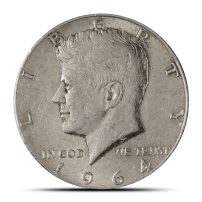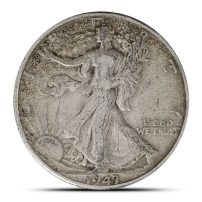


The United States half dollar was the second-largest denomination of US silver currency for more than a century and, today, is the largest US coin circulating by size and weight. The only US silver coin ever issued that was larger than the half dollar was the US silver dollar. Unlike many of its historic counterparts, the US half dollar has been produced every year since 1794. Like other silver coins from American history, the half dollar has gone through various designs through its history. From 1839 to 1964, the coins were available with 90% silver. Now you have the opportunity to learn all about the history of 90% silver half dollars.
The first US half dollar, 50-cent, coins were issued by the United States Mint in 1794. For the first two years of issue, the coins were produced with the Flowing Hair design. From 1796 to 1807, the US Mint issued the coins with the Draped Bust design that originally featured a small heraldic eagle, but later featured a larger heraldic eagle. The final design series issued prior to 90% silver coinage was the Capped Bust design in use on the half dollar from 1807 to 1839. This series also went through slight changes with a larger head design originally and a smaller design in the final three years. These coins were issued with silver mixtures that often featured 89.2% silver and 10.8% copper.
Starting in 1839, the United States Mint issued half-dollar coins with .365 Troy oz of 90% silver. The silver content of the coins was offset by 10% copper for durability in circulation. The first design to feature this metal content mixture was the Seated Liberty design. Created by Christian Gobrecht, who later served as the 3rd Chief Engraver of the United States Mint, the Seated Liberty design was used across several denominations of US currency. The design included the following elements:
The Barber Coinage Series was available from the United States Mint from 1892 to 1916. The series is so-named because the common designs used on the dime, quarter, and half dollar of this collection were created by 6th Chief Engraver of the United States Mint, Charles E. Barber. He created a Liberty bust that featured on the obverse of all three denominations, and two separate reverse designs. His reverse imagery included a unique visual for the dime and shared designs for the quarter and half dollar. The 90% Silver Barber Half Dollar featured these designs:
Arguably the most popular half-dollar design to feature in the 90% Silver Half Dollar Series, the Walking Liberty Half Dollar replaced the unpopular Barber Half Dollar design in 1916. Used on the coins from 1916 to 1947, the Walking Liberty design was so popular it has been revived by the mint in the modern era as the face of the American Silver Eagle. Designed by Adolph A. Weinman, the Walking Liberty coinage features these elements:
The Walking Liberty design was replaced by the United States Mint in 1948 with a bust of Founding Father Benjamin Franklin. The design of Franklin was used for just 15 years, the shortest in the 20th century and the shortest in the series since the Draped Bust design issued from 1796 to 1807. The images on the obverse and reverse of the Franklin Half Dollar were created by John R. Sinnock and Gilroy Roberts, respectively. Sinnock was the 8th Chief Engraver of the United States Mint and Roberts the 9th Chief Engraver of the United States Mint. The designs on this coin include:
The Kennedy Half Dollar was introduced in March 1964, just four months after the assassination of President John F. Kennedy while in office. The Kennedy Half Dollar was the final US silver coin design introduced in the 90% silver era and was only available for one year in 9% silver. The 1964 Kennedy Half Dollar was the final issue of this type of silver and featured designs of:
After the 1964 Kennedy Half Dollar was released, all silver coins in the United States were transitioned to a modern cupro-nickel alloy for greater durability in circulation and affordability in production. All US coins issued starting in 1965 have no actual silver content.
You will find 90% Silver Half Dollars available from JM Bullion varying batches and conditions. If you have questions, please call JM Bullion at 800-276-6508. We are also available to you on the web through our live chat and email address features.